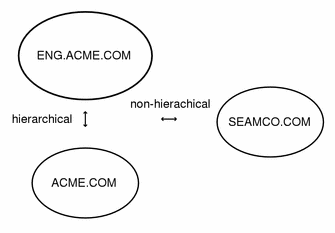Realms
A realm is a logical network, like a domain, which defines a group of systems under the same master KDC. The figure below shows how realms can relate to one another. Some realms are hierarchical, with one being a superset of the other. Otherwise, the realms are non-hiearchical and the mapping between the two realms must be defined. A feature of SEAM is that it permits authentication across realms; each realm only needs to have a principal entry for the other realm in its KDC.
Figure 21-1 Realms

Realms and Servers
Each realm must include a server that maintains the master copy of the principal database. This is called the master KDC server. Additionally, each realm should contain at least one slave KDC server, which contains duplicate copies of the principal database. Both the master and the slave KDC servers create tickets used to establish authentication.
The realm can also include two additional types of SEAM servers. A SEAM network application server is a server that provides access to Kerberized applications (such as ftp, telnet and rsh). Realms can also include NFS servers, which provide NFS services, using Kerberos authentication.
The figure below shows what a hypothetical realm might contain.
Figure 21-2 A Typical Realm

- © 2010, Oracle Corporation and/or its affiliates
